The Role of Information Asymmetry in Insurance Market Dynamics
VerifiedAdded on 2022/11/29
|5
|1449
|93
Essay
AI Summary
This essay delves into the concept of information asymmetry within the insurance market, exploring how unequal access to information between buyers and sellers affects market dynamics. It examines the two primary issues arising from this asymmetry: adverse selection, where those at higher risk are more likely to seek insurance, and moral hazard, where behavior changes post-insurance. The paper discusses how information asymmetry influences pricing, market failure, and the behavior of both insurers and insured individuals across different types of insurance, including health and automobile insurance. The analysis includes the impact of information asymmetry on pricing, market failure, and the behaviors of both insurers and insured individuals, and also refers to relevant research and the work of key scholars in the field, such as Chiappori, Cohen, and Healy and Palepu, to support its arguments.
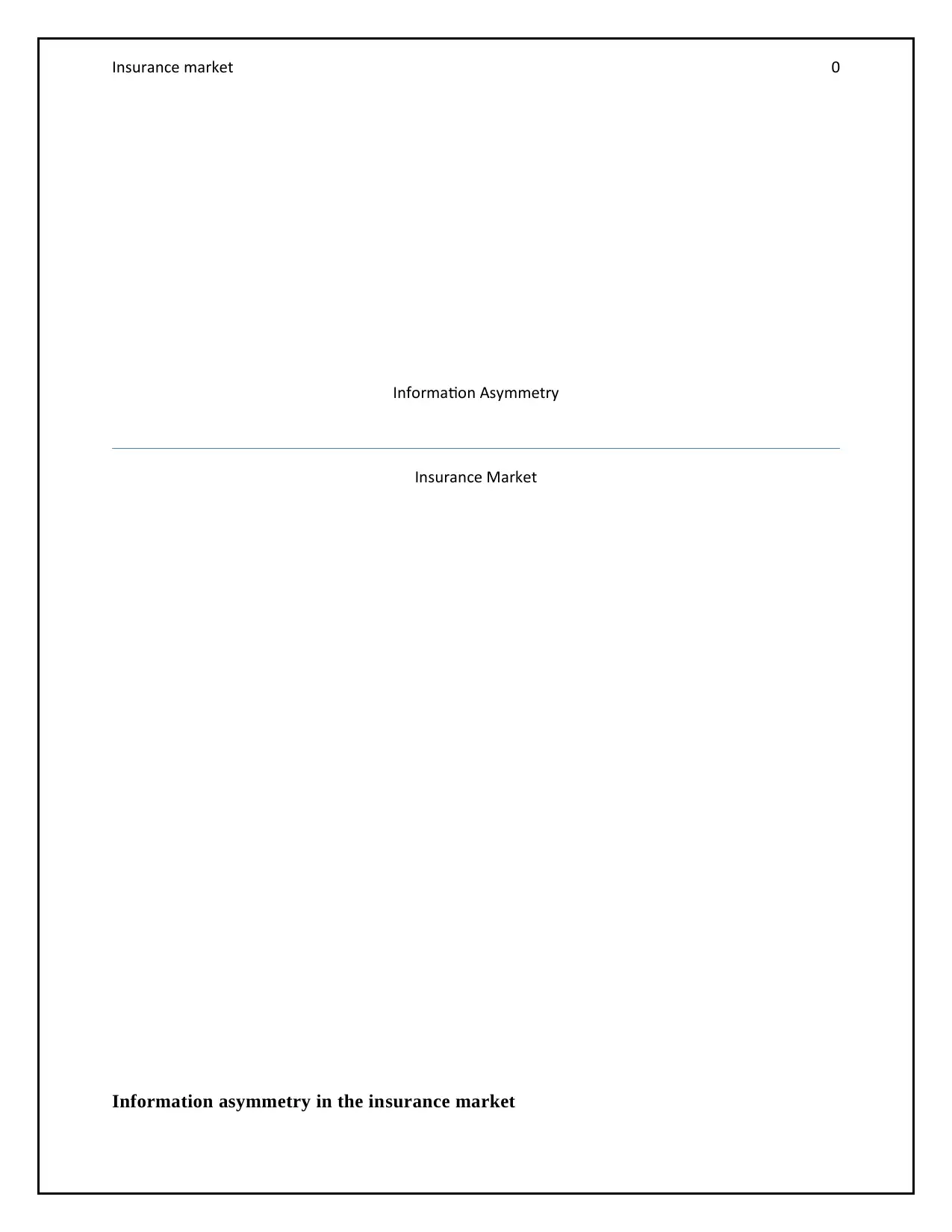
Insurance market 0
Information Asymmetry
Insurance Market
Information asymmetry in the insurance market
Information Asymmetry
Insurance Market
Information asymmetry in the insurance market
Paraphrase This Document
Need a fresh take? Get an instant paraphrase of this document with our AI Paraphraser
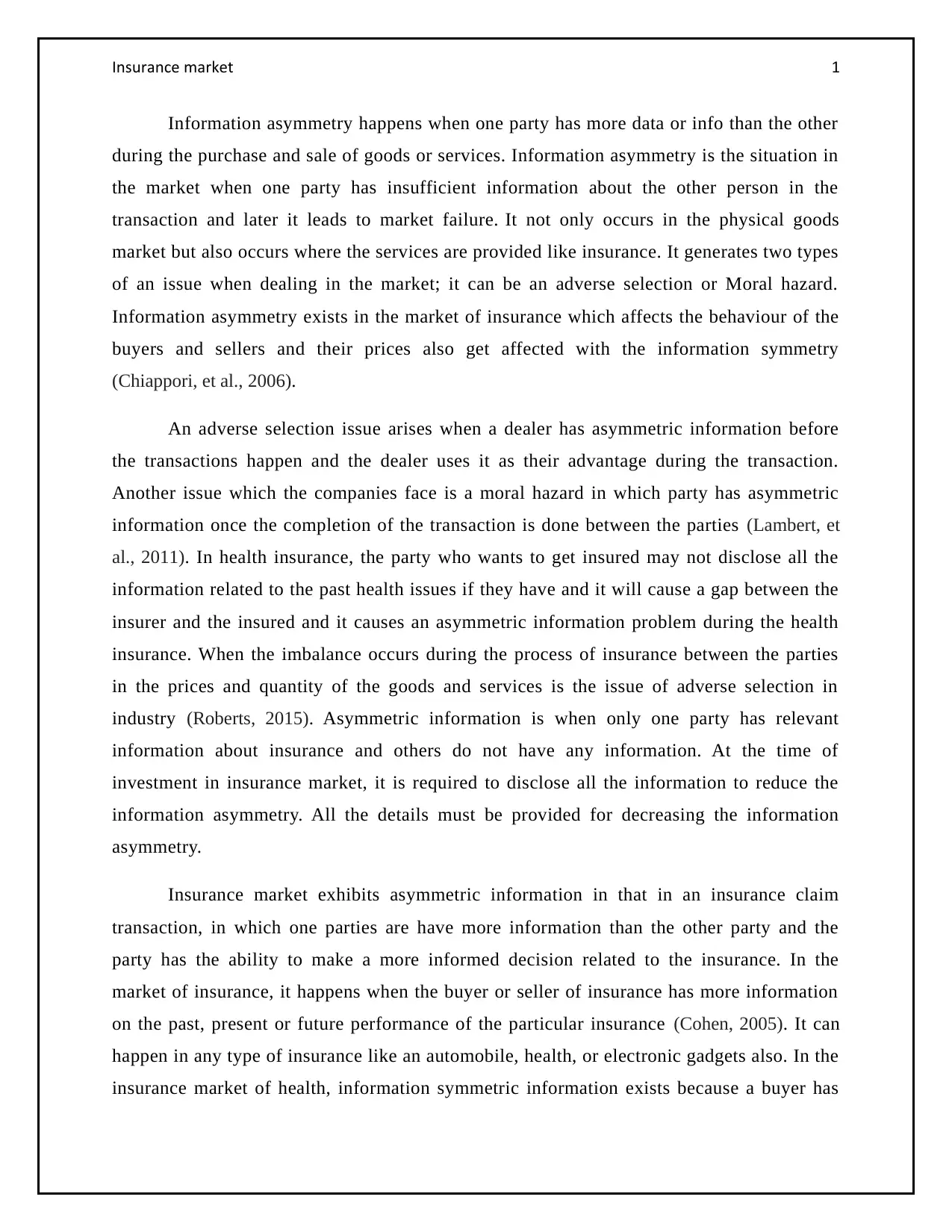
Insurance market 1
Information asymmetry happens when one party has more data or info than the other
during the purchase and sale of goods or services. Information asymmetry is the situation in
the market when one party has insufficient information about the other person in the
transaction and later it leads to market failure. It not only occurs in the physical goods
market but also occurs where the services are provided like insurance. It generates two types
of an issue when dealing in the market; it can be an adverse selection or Moral hazard.
Information asymmetry exists in the market of insurance which affects the behaviour of the
buyers and sellers and their prices also get affected with the information symmetry
(Chiappori, et al., 2006).
An adverse selection issue arises when a dealer has asymmetric information before
the transactions happen and the dealer uses it as their advantage during the transaction.
Another issue which the companies face is a moral hazard in which party has asymmetric
information once the completion of the transaction is done between the parties (Lambert, et
al., 2011). In health insurance, the party who wants to get insured may not disclose all the
information related to the past health issues if they have and it will cause a gap between the
insurer and the insured and it causes an asymmetric information problem during the health
insurance. When the imbalance occurs during the process of insurance between the parties
in the prices and quantity of the goods and services is the issue of adverse selection in
industry (Roberts, 2015). Asymmetric information is when only one party has relevant
information about insurance and others do not have any information. At the time of
investment in insurance market, it is required to disclose all the information to reduce the
information asymmetry. All the details must be provided for decreasing the information
asymmetry.
Insurance market exhibits asymmetric information in that in an insurance claim
transaction, in which one parties are have more information than the other party and the
party has the ability to make a more informed decision related to the insurance. In the
market of insurance, it happens when the buyer or seller of insurance has more information
on the past, present or future performance of the particular insurance (Cohen, 2005). It can
happen in any type of insurance like an automobile, health, or electronic gadgets also. In the
insurance market of health, information symmetric information exists because a buyer has
Information asymmetry happens when one party has more data or info than the other
during the purchase and sale of goods or services. Information asymmetry is the situation in
the market when one party has insufficient information about the other person in the
transaction and later it leads to market failure. It not only occurs in the physical goods
market but also occurs where the services are provided like insurance. It generates two types
of an issue when dealing in the market; it can be an adverse selection or Moral hazard.
Information asymmetry exists in the market of insurance which affects the behaviour of the
buyers and sellers and their prices also get affected with the information symmetry
(Chiappori, et al., 2006).
An adverse selection issue arises when a dealer has asymmetric information before
the transactions happen and the dealer uses it as their advantage during the transaction.
Another issue which the companies face is a moral hazard in which party has asymmetric
information once the completion of the transaction is done between the parties (Lambert, et
al., 2011). In health insurance, the party who wants to get insured may not disclose all the
information related to the past health issues if they have and it will cause a gap between the
insurer and the insured and it causes an asymmetric information problem during the health
insurance. When the imbalance occurs during the process of insurance between the parties
in the prices and quantity of the goods and services is the issue of adverse selection in
industry (Roberts, 2015). Asymmetric information is when only one party has relevant
information about insurance and others do not have any information. At the time of
investment in insurance market, it is required to disclose all the information to reduce the
information asymmetry. All the details must be provided for decreasing the information
asymmetry.
Insurance market exhibits asymmetric information in that in an insurance claim
transaction, in which one parties are have more information than the other party and the
party has the ability to make a more informed decision related to the insurance. In the
market of insurance, it happens when the buyer or seller of insurance has more information
on the past, present or future performance of the particular insurance (Cohen, 2005). It can
happen in any type of insurance like an automobile, health, or electronic gadgets also. In the
insurance market of health, information symmetric information exists because a buyer has
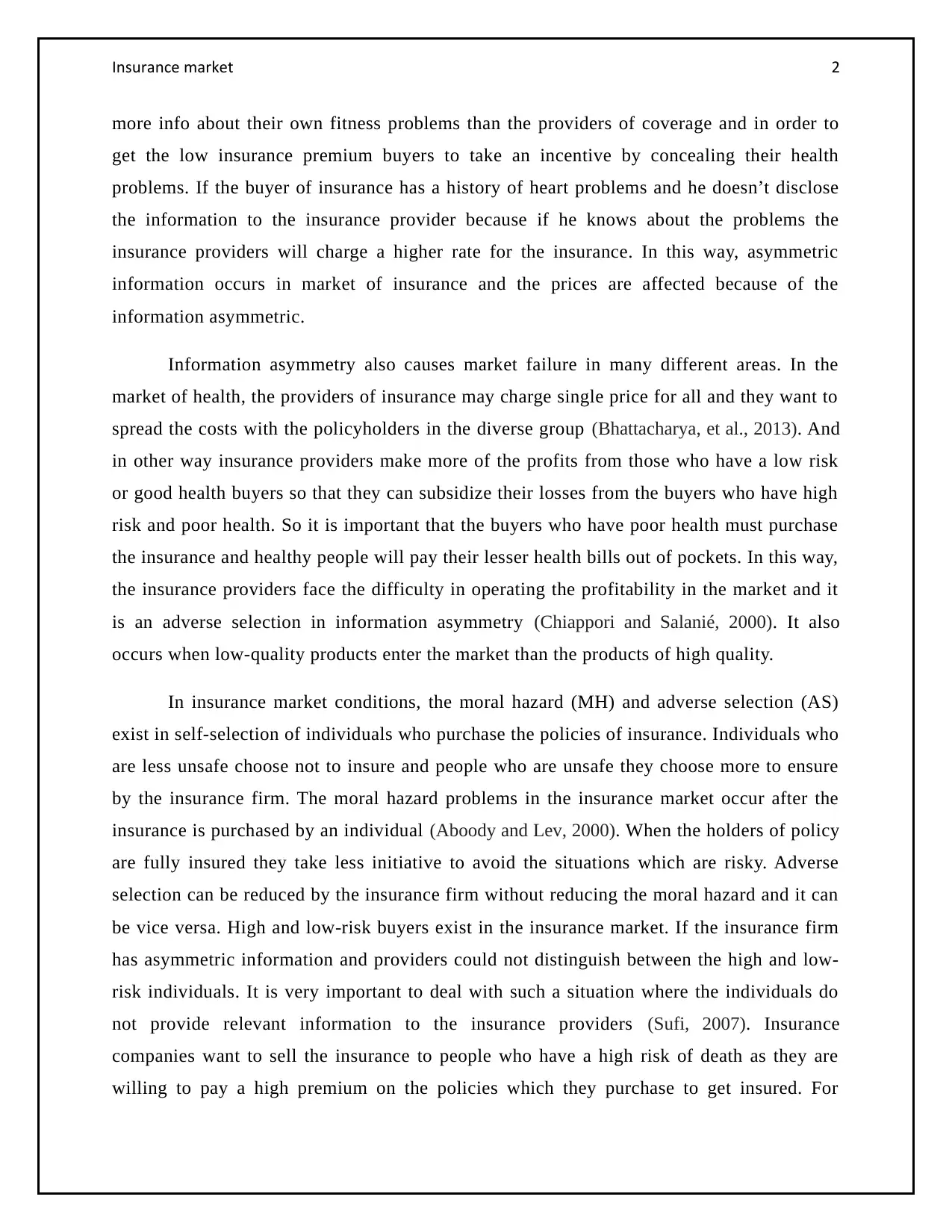
Insurance market 2
more info about their own fitness problems than the providers of coverage and in order to
get the low insurance premium buyers to take an incentive by concealing their health
problems. If the buyer of insurance has a history of heart problems and he doesn’t disclose
the information to the insurance provider because if he knows about the problems the
insurance providers will charge a higher rate for the insurance. In this way, asymmetric
information occurs in market of insurance and the prices are affected because of the
information asymmetric.
Information asymmetry also causes market failure in many different areas. In the
market of health, the providers of insurance may charge single price for all and they want to
spread the costs with the policyholders in the diverse group (Bhattacharya, et al., 2013). And
in other way insurance providers make more of the profits from those who have a low risk
or good health buyers so that they can subsidize their losses from the buyers who have high
risk and poor health. So it is important that the buyers who have poor health must purchase
the insurance and healthy people will pay their lesser health bills out of pockets. In this way,
the insurance providers face the difficulty in operating the profitability in the market and it
is an adverse selection in information asymmetry (Chiappori and Salanié, 2000). It also
occurs when low-quality products enter the market than the products of high quality.
In insurance market conditions, the moral hazard (MH) and adverse selection (AS)
exist in self-selection of individuals who purchase the policies of insurance. Individuals who
are less unsafe choose not to insure and people who are unsafe they choose more to ensure
by the insurance firm. The moral hazard problems in the insurance market occur after the
insurance is purchased by an individual (Aboody and Lev, 2000). When the holders of policy
are fully insured they take less initiative to avoid the situations which are risky. Adverse
selection can be reduced by the insurance firm without reducing the moral hazard and it can
be vice versa. High and low-risk buyers exist in the insurance market. If the insurance firm
has asymmetric information and providers could not distinguish between the high and low-
risk individuals. It is very important to deal with such a situation where the individuals do
not provide relevant information to the insurance providers (Sufi, 2007). Insurance
companies want to sell the insurance to people who have a high risk of death as they are
willing to pay a high premium on the policies which they purchase to get insured. For
more info about their own fitness problems than the providers of coverage and in order to
get the low insurance premium buyers to take an incentive by concealing their health
problems. If the buyer of insurance has a history of heart problems and he doesn’t disclose
the information to the insurance provider because if he knows about the problems the
insurance providers will charge a higher rate for the insurance. In this way, asymmetric
information occurs in market of insurance and the prices are affected because of the
information asymmetric.
Information asymmetry also causes market failure in many different areas. In the
market of health, the providers of insurance may charge single price for all and they want to
spread the costs with the policyholders in the diverse group (Bhattacharya, et al., 2013). And
in other way insurance providers make more of the profits from those who have a low risk
or good health buyers so that they can subsidize their losses from the buyers who have high
risk and poor health. So it is important that the buyers who have poor health must purchase
the insurance and healthy people will pay their lesser health bills out of pockets. In this way,
the insurance providers face the difficulty in operating the profitability in the market and it
is an adverse selection in information asymmetry (Chiappori and Salanié, 2000). It also
occurs when low-quality products enter the market than the products of high quality.
In insurance market conditions, the moral hazard (MH) and adverse selection (AS)
exist in self-selection of individuals who purchase the policies of insurance. Individuals who
are less unsafe choose not to insure and people who are unsafe they choose more to ensure
by the insurance firm. The moral hazard problems in the insurance market occur after the
insurance is purchased by an individual (Aboody and Lev, 2000). When the holders of policy
are fully insured they take less initiative to avoid the situations which are risky. Adverse
selection can be reduced by the insurance firm without reducing the moral hazard and it can
be vice versa. High and low-risk buyers exist in the insurance market. If the insurance firm
has asymmetric information and providers could not distinguish between the high and low-
risk individuals. It is very important to deal with such a situation where the individuals do
not provide relevant information to the insurance providers (Sufi, 2007). Insurance
companies want to sell the insurance to people who have a high risk of death as they are
willing to pay a high premium on the policies which they purchase to get insured. For
⊘ This is a preview!⊘
Do you want full access?
Subscribe today to unlock all pages.

Trusted by 1+ million students worldwide
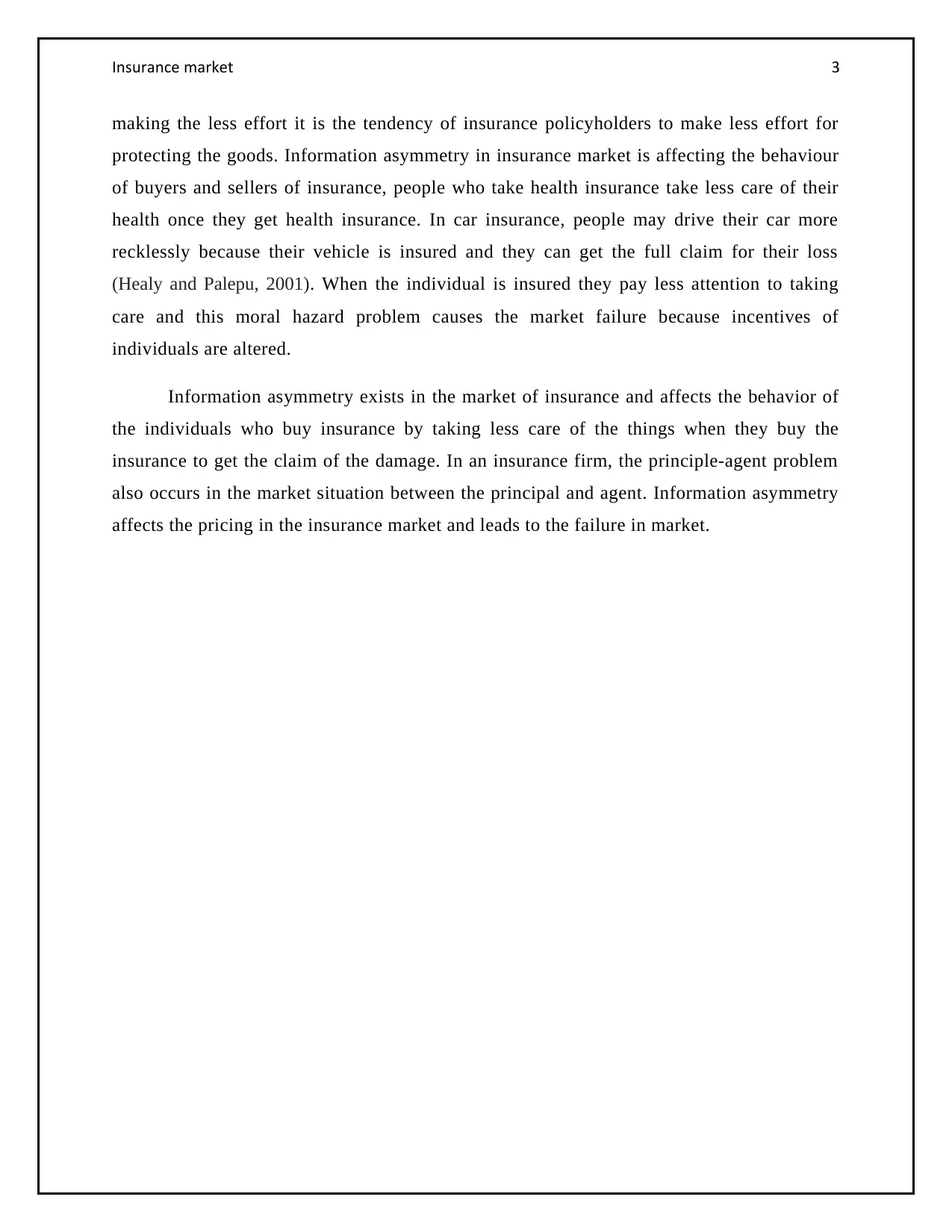
Insurance market 3
making the less effort it is the tendency of insurance policyholders to make less effort for
protecting the goods. Information asymmetry in insurance market is affecting the behaviour
of buyers and sellers of insurance, people who take health insurance take less care of their
health once they get health insurance. In car insurance, people may drive their car more
recklessly because their vehicle is insured and they can get the full claim for their loss
(Healy and Palepu, 2001). When the individual is insured they pay less attention to taking
care and this moral hazard problem causes the market failure because incentives of
individuals are altered.
Information asymmetry exists in the market of insurance and affects the behavior of
the individuals who buy insurance by taking less care of the things when they buy the
insurance to get the claim of the damage. In an insurance firm, the principle-agent problem
also occurs in the market situation between the principal and agent. Information asymmetry
affects the pricing in the insurance market and leads to the failure in market.
making the less effort it is the tendency of insurance policyholders to make less effort for
protecting the goods. Information asymmetry in insurance market is affecting the behaviour
of buyers and sellers of insurance, people who take health insurance take less care of their
health once they get health insurance. In car insurance, people may drive their car more
recklessly because their vehicle is insured and they can get the full claim for their loss
(Healy and Palepu, 2001). When the individual is insured they pay less attention to taking
care and this moral hazard problem causes the market failure because incentives of
individuals are altered.
Information asymmetry exists in the market of insurance and affects the behavior of
the individuals who buy insurance by taking less care of the things when they buy the
insurance to get the claim of the damage. In an insurance firm, the principle-agent problem
also occurs in the market situation between the principal and agent. Information asymmetry
affects the pricing in the insurance market and leads to the failure in market.
Paraphrase This Document
Need a fresh take? Get an instant paraphrase of this document with our AI Paraphraser
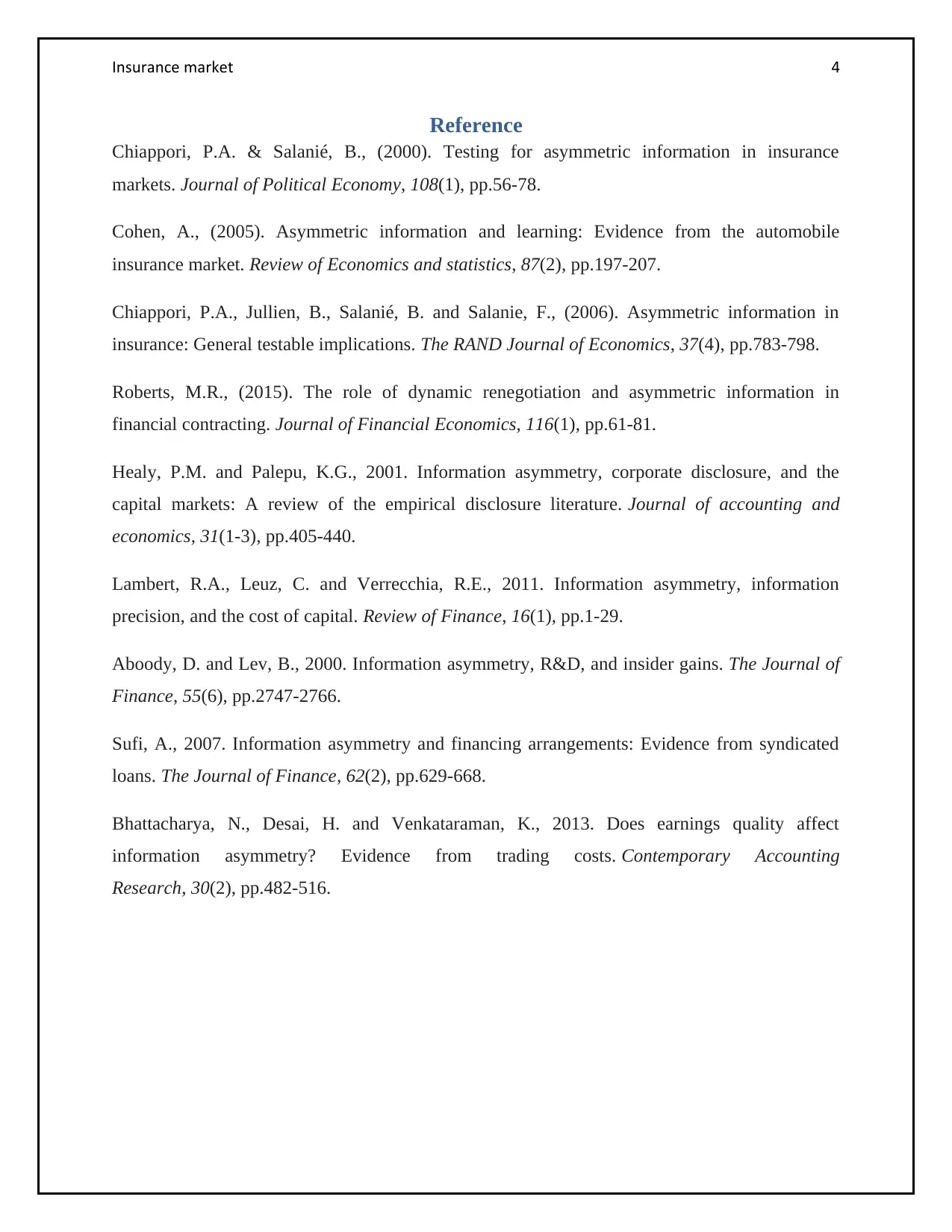
Insurance market 4
Reference
Chiappori, P.A. & Salanié, B., (2000). Testing for asymmetric information in insurance
markets. Journal of Political Economy, 108(1), pp.56-78.
Cohen, A., (2005). Asymmetric information and learning: Evidence from the automobile
insurance market. Review of Economics and statistics, 87(2), pp.197-207.
Chiappori, P.A., Jullien, B., Salanié, B. and Salanie, F., (2006). Asymmetric information in
insurance: General testable implications. The RAND Journal of Economics, 37(4), pp.783-798.
Roberts, M.R., (2015). The role of dynamic renegotiation and asymmetric information in
financial contracting. Journal of Financial Economics, 116(1), pp.61-81.
Healy, P.M. and Palepu, K.G., 2001. Information asymmetry, corporate disclosure, and the
capital markets: A review of the empirical disclosure literature. Journal of accounting and
economics, 31(1-3), pp.405-440.
Lambert, R.A., Leuz, C. and Verrecchia, R.E., 2011. Information asymmetry, information
precision, and the cost of capital. Review of Finance, 16(1), pp.1-29.
Aboody, D. and Lev, B., 2000. Information asymmetry, R&D, and insider gains. The Journal of
Finance, 55(6), pp.2747-2766.
Sufi, A., 2007. Information asymmetry and financing arrangements: Evidence from syndicated
loans. The Journal of Finance, 62(2), pp.629-668.
Bhattacharya, N., Desai, H. and Venkataraman, K., 2013. Does earnings quality affect
information asymmetry? Evidence from trading costs. Contemporary Accounting
Research, 30(2), pp.482-516.
Reference
Chiappori, P.A. & Salanié, B., (2000). Testing for asymmetric information in insurance
markets. Journal of Political Economy, 108(1), pp.56-78.
Cohen, A., (2005). Asymmetric information and learning: Evidence from the automobile
insurance market. Review of Economics and statistics, 87(2), pp.197-207.
Chiappori, P.A., Jullien, B., Salanié, B. and Salanie, F., (2006). Asymmetric information in
insurance: General testable implications. The RAND Journal of Economics, 37(4), pp.783-798.
Roberts, M.R., (2015). The role of dynamic renegotiation and asymmetric information in
financial contracting. Journal of Financial Economics, 116(1), pp.61-81.
Healy, P.M. and Palepu, K.G., 2001. Information asymmetry, corporate disclosure, and the
capital markets: A review of the empirical disclosure literature. Journal of accounting and
economics, 31(1-3), pp.405-440.
Lambert, R.A., Leuz, C. and Verrecchia, R.E., 2011. Information asymmetry, information
precision, and the cost of capital. Review of Finance, 16(1), pp.1-29.
Aboody, D. and Lev, B., 2000. Information asymmetry, R&D, and insider gains. The Journal of
Finance, 55(6), pp.2747-2766.
Sufi, A., 2007. Information asymmetry and financing arrangements: Evidence from syndicated
loans. The Journal of Finance, 62(2), pp.629-668.
Bhattacharya, N., Desai, H. and Venkataraman, K., 2013. Does earnings quality affect
information asymmetry? Evidence from trading costs. Contemporary Accounting
Research, 30(2), pp.482-516.
1 out of 5
Related Documents
Your All-in-One AI-Powered Toolkit for Academic Success.
+13062052269
info@desklib.com
Available 24*7 on WhatsApp / Email
![[object Object]](/_next/static/media/star-bottom.7253800d.svg)
Unlock your academic potential
Copyright © 2020–2025 A2Z Services. All Rights Reserved. Developed and managed by ZUCOL.





